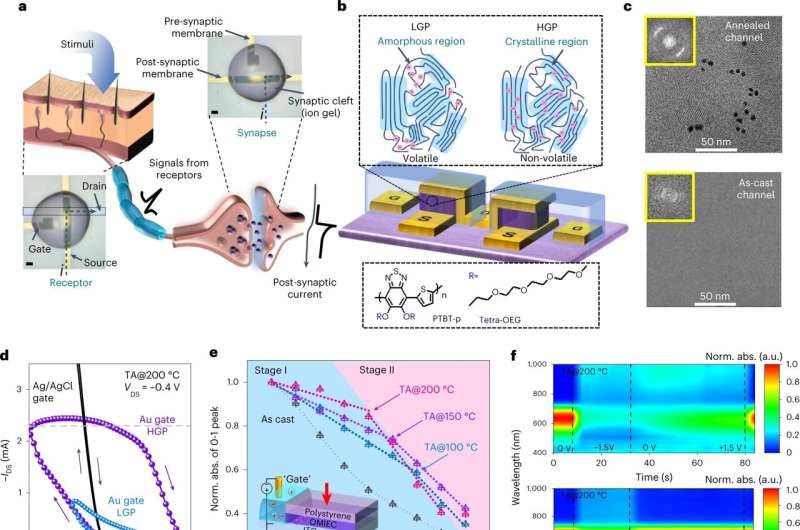An organic electrochemical transistor that serves as a sensor and processor
In recent years, electronics engineers have been trying to develop new brain-inspired hardware that can run artificial intelligence (AI) models more efficiently. While most existing hardware is specialized in either sensing, processing or storing data, some teams have been exploring the possibility of combining these three functionalities in a single device.
Researchers at Xi’an Jiaotong University, the University of Hong Kong and Xi’an University of Science and Technology introduced a new organic transistor that can act as a sensor and processor. This transistor, introduced in a paper published in Nature Electronics, is based on a vertical traverse architecture and a crystalline-amorphous channel that can be selectively doped by ions, allowing it to switch between two reconfigurable modes.
“Conventional artificial intelligence (AI) hardware uses separate systems for data sensing, processing, and memory storage,” Prof. Wei Ma and Prof. Zhongrui Wang, two of the researchers who carried out the study, told Tech Xplore.
“This separation often leads to significant energy consumption and time delays due to the constant need for data transfer between different hardware components and the sequential conversion of analog to digital signals. Some ground-breaking studies have highlighted the remarkable sensing and analog memory capabilities of organic electrochemical transistors (OECTs).”
The initial objective of the researchers’ recent study was to develop an OECT that can work both as a sensor and processor, as such a device could enable the creation of more homogeneous and efficient AI hardware. OECTs are thin film-based organic electronic devices that function as transistors. Their thinness makes them particularly promising for the development of smart bioelectronics, such as wearable or implantable devices, and neuromorphic hardware.
The OECT developed by Wang, Chen and their colleagues has two different modes of operation, namely a sensing and a processing mode. These two different modes are supported via the selective ion doping of a crystalline-amorphous channel inside in the device.
“In the sensing mode, ions in the electrolyte, driven by a physiological signal, migrate into the crystal structure, but they can easily diffuse back into the electrolyte, keeping the channel in a low-conductance state,” Wang explained. “In the processing mode, these ions can be ‘trapped’ by the crystal structure, maintaining the channel in a high-conductance state. This dual functionality makes our OECT device unique and efficient.”
To manufacture their OECT array, the researchers used a series of straightforward techniques and processes, including thermal evaporation, solution blade coating, thermal annealing, and reactive ion etching. As all these techniques are cost-effective, they could facilitate the large-scale fabrication of their device.
“Our device also boasts impressive versatility,” Wang said. “As a sensor, it can detect various kinds of signals, such as those from electrophysiology, chemical species, light, and temperature. Furthermore, as a memory unit, it offers a range of benefits like the ability to store 10-bit analog states, low switching randomness, and a state retention of over 10,000 seconds. This makes our OECT device a versatile tool in the world of AI.”
Wang, Chen and their colleagues evaluated their device and its ability to switch between its different operating modes in a series of experiments. They found that their OECT’s dynamics could be effectively modulated, allowing it to function well both as a sensor and processor.
As a sensor, the device can sense different type of stimuli, including ions and light. As a processor, it is capable of 10-bit analogue states, while also retaining these states well.
“The novel device we developed features two distinct operating schemes due to where ions are trapped,” Shijie said. “As a result, it functions as both a sensor and processor. This reconfigurability is bio-inspired, which also makes future neuromorphic hardware more versatile and adaptable.”
In the future, the transistor created by this team of researchers could be used to create advanced neuromorphic devices that can collect different types of data and process it. As part of their study, Wang, Chen and their colleagues showed that it could be used to diagnose cardiac diseases in real-time and their next works could explore more promising applications.
“We are currently planning to refine our fabrication technology with the aim of creating a large-scale OECT array,” Wang added. “This will lay the foundation for a fully integrated sensing-processing neural network. The potential applications of this technology are extensive and could revolutionize fields such as healthcare. For instance, it could enable real-time disease diagnosis using hardware alone, a breakthrough that could greatly enhance speed and accuracy in medical settings.”
More information:
Shijie Wang et al, An organic electrochemical transistor for multi-modal sensing, memory and processing, Nature Electronics (2023). DOI: 10.1038/s41928-023-00950-y
© 2023 Science X Network
Citation:
An organic electrochemical transistor that serves as a sensor and processor (2023, June 2)
retrieved 3 June 2023
from https://techxplore.com/news/2023-05-electrochemical-transistor-sensor-processor.html
This document is subject to copyright. Apart from any fair dealing for the purpose of private study or research, no
part may be reproduced without the written permission. The content is provided for information purposes only.

Comments are closed